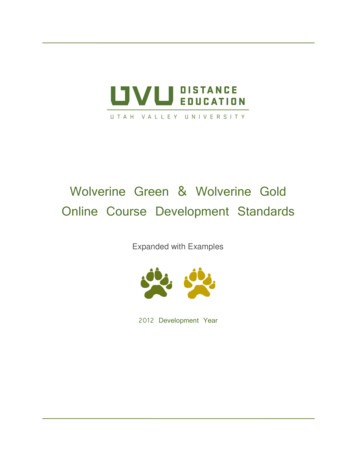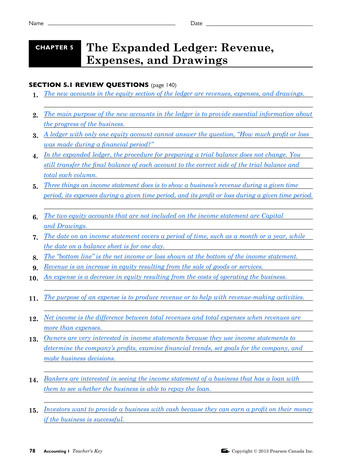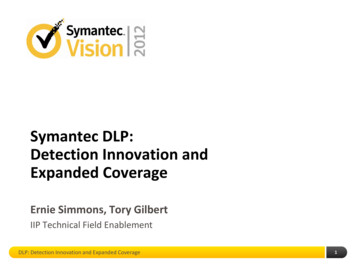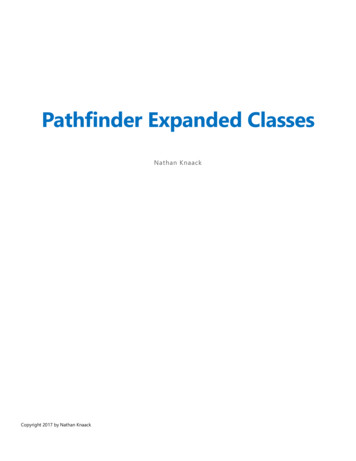
Transcription
Wolverine Green & Wolverine GoldOnline Course Development StandardsExpanded with Examples2012 Development Year
UVU Distance EducationInstructional Design ServicesWolverine Green & Gold Development Standards2012 Development YearIntroductionIn an effort to increase the robustness and interaction of UVU’s online course offerings,Distance Education has established minimum standards of development quality forwhich it will issue both endorsement and compensation. These minimum standards aredesignated as Wolverine Green and Wolverine Gold, but there is no qualitativedifference between Green and Gold designations. Gold ratings are reserved for largeenrollment courses or bottleneck courses as determined by the Office of AcademicAffairs. In order to garner a Wolverine Green/Gold designation, a course must containthe following elements:Part A: These materials are generally provided to the course byInstructional Design Services (IDS) but may be modified asnecessary. For current examples, contact IDS directly. Thesematerials include:Course Overview – taken from COMET: Course descriptionCourse goals and objectivesProgram requirements and prerequisites (instructors may add skills andequipment needed to successfully participate)UVU - Policies and Services: Academic integrity policyDisability policyStudent support informationStudent rights and responsibilities statementParking informationUVU student success linksDistance Education disclaimerNetiquette statementEvaluations: Summative course evaluationVersion 1Page 1 of 19
UVU Distance EducationPart B:Instructional Design ServicesMaterials for the course that will be co-created between aninstructional designer and faculty member. These materials include:Instructor Information Educational background: A brief introduction to the instructor’s background andparticular interests in the course subject matter. A picture of the instructor shouldalso be included to make the course more personal for the students.Example:Hi. My name is [Professor Smith]. College Success Studies is a veryspecial course for me because helping people become successful is mymission in life. The learning and motivation strategies that we teach in thiscourse come from studying successful people, and I use them myself. I'malso a big fan of UVU. I have wonderful colleagues here, and, as aninstitution, we are leaders in my field of learning and motivation strategies.Background & Academic CredentialsI can relate to your challenges as a student. I recently received mydoctorate in Educational Psychology, which is the science of teaching andlearning. I also have degrees in law, food science, and biology.Despite becoming a teacher rather late in life, I have lots of experiencewith this course, having taught it more than 35 times to over 800 students.My prior careers have also prepared me to teach the class. I founded andsuccessfully ran a recruiting business for 10 years before selling it toreturn to college to become an educational psychologist. Prior to that Iworked for a Fortune 100 company for 20 years as an executive andmanager. Virtual & Real Office Hours Contact information, policies, and procedures: Information and availabilitytimes for multiple methods of student contact (e.g., email, phone, instantmessaging, etc.). Should also include information about real, virtual office hours,timeliness of replies, preferred methods of and required procedures for instructorcontact, etc. Some explanation of the instructor’s level of involvement should alsobe included (e.g., participation in discussion boards, planned emails, anticipatedfeedback on assignments, timeliness of assignment evaluations, plans to holdonline conferences, etc.).Version 1Page 2 of 19
UVU Distance EducationInstructional Design ServicesExample: [Professor Smith]Phone: 801-555-1212E-Mail: Course Inbox (preferred)Office: LC 409Office Hours: by appointmentVirtual Office Hours: MWF 7-9 a.m. TT 4-6 p.m. Mountain TimeThe preferred method of communicating with the instructor is through thecourse inbox. Be assured that your messages through the course arewatched carefully and will be responded to in a timely manner.o There will be a forum in the Discussions where you can post questions youmay have regarding assignments or technical problems. Questions posted inthis area will be answered promptly and will help other students who mayhave the same questions.o Student responsibilities: An explanation of general student responsibilitiesthroughout the course. This is more broad than the modus operandi outlined inthe course guide and should help students understand the types of behavior andskill that are expected in completing the course. In general, students areexpected to perform in accordance with The Student Rights and ResponsibilitiesCode - Policy icies/show/policyid/172). This shouldinclude information about the time commitment for the course. It may also includeresources for and/or information about study strategies, time management, andstudent success.Example:An outline of what is expected in this course:o Learn the Canvas software through the tutorial and contact me or theHelp Desk if you have any problems with aspects of the course.o Learn to use the communication tools used in the class, and participatein online group meetings, if applicable.o Assume increased accountability for course content and acquisition,including adequate preparation through related readings, participationin class discussion where appropriate, and preparation of variousmaterials required for the learning activities.o Complete all assignments on time as defined in the Course Scheduleo Abide by ethical standards. Your work must be your own. Instructor responsibilities: A description of the instructor’s roles andcommitments throughout the course, indicating what you will and will not do asstudents participate in the course.Version 1Page 3 of 19
UVU Distance EducationInstructional Design ServicesExample:o Maintain an active presence in class.o Respond to emails within ONE business day. (Emails receivedFridays after 12:00 pm MST will be responded to by noon on thefollowing Monday.) If I receive multiple emails regarding the samequestion or concern, I may post a general reply to the entire classas an announcement.o Provide timely, meaningful and constructive feedback onassignments.o Help guide and facilitate students through course material toprovide an effective learning experience.Course Information: Getting Started:o Getting started information: A brief introduction to the online courseincluding how to get started, what to do first, how the LearningManagement System will be utilized, etc. (May be in written or video form.)Example: Begin by becoming familiar with your course in Canvas. If youhave difficulty accessing Canvas, contact Distance Education TechnicalSupport: Live Help: http://www.uvu.edu/de/ then click on Live Help(upper left corner)Email: dehelp@uvu.eduTelephone: (801)863-8255 (Utah County)(888)425-4412 (Toll Free)Fax: (801)863-7298Read through the online Course Orientation materials and become familiarwith the policies and procedures for this course. Then take the CourseOrientation quiz included in the Course Orientation module. Take this quizas many times as necessary to achieve a 100% score which will releasefull course materials. Completing this quiz ensures that all courseexpectations are clear.o Instructor Welcome: A discussion of the course content, objectives, andprocedures in the instructor’s own words.Version 1Page 4 of 19
UVU Distance EducationInstructional Design ServicesExample: Welcome to Tribal Art History. We will research, discuss, andendeavor to understand tribal artmaking and culture in the Americas,Africa, and Australia. My name is [Professor Jones] and I teach in the ArtDepartment. I am an artist with an MFA in printmaking. Although I teach anumber of courses outside the studio area, I communicate far better withpictures than I do with words. Please keep that in mind as you readthrough this document and work your way through this course. Point outany areas you feel are unclear. Please ask questions until you haveanswers. My contact information is below; please call or email as often asyou need. Notice my online course office hours are posted and unless I letyou know in advance to the contrary, I will be in my office and available foryou during that time.There is no primary text for the course but there are several textsand sources you will be using, some of which are listed later in thisdocument. Please be aware that any source you find on the subjectof tribal culture, art included, that is not written by an author fromthe culture of which she or he speaks could have a skewedperspective. Much of what is considered Tribal Art making is basedin spiritual belief and ceremony. And unless one is of the culture, itis difficult to fully understand both the perspective of the belief andthe connections artmaking might have to it.Also, any part of the culture and artmaking connected spiritualbelief may be considered very sacred to the people from which itcomes. We, individually and as a group, must honor thatsacredness and treat it with respect. This is not a course on religionand no religious beliefs will be taught, but we must remember someof what we discuss will be part of someone’s spiritual / religiouspractice and we must approach our conversations with that in mind.Many objects that are used in tribal ceremonies, which could beconsidered art objects, are considered too sacred to bephotographed or even viewed by outsiders. Many of these objectsstill remain in the collections of museums and individualcollectors this includes the bones of ancestors. We will try to stayaway from sharing images that fall into this category and thusperpetuating any known infraction of this type. If we follow the ruleof carefully choosing our sources and selecting images from thesesources to share with our group and cite those sources correctly,we should be able to function as an academic unit and still berespectful.If you haven’t already guessed, this is a research-based course. You willneed, rather than purchase expensive texts, to subscribe to either NetflixVersion 1Page 5 of 19
UVU Distance EducationInstructional Design Servicesor Blockbuster and purchase one novel. We will be viewing films on ourfocus areas. You will also need to become comfortable researching invarious environments. It is always best to go to primary sources forresearch, but often we will not be able to find those. We will work throughall of these trials and hurdles together.o A methodology statement: A broad overview of the instructionalmethodologies and strategies the instructor intends to utilize throughoutthe course and the instructor’s rationale for that approach.Example: A blend of instructional strategies will be utilized through thiscourse. A conscious effort to use the Models of Instruction, adapted toonline instruction, has been made. Hopefully you will be able to identifyteaching strategies that you will be able to incorporate into your teaching.This course will not be totally self-paced. In some online courses you mayproceed at your own rate through the coursework. The model that wehave chosen will have designated blocks of time that a module will need tobe completed within. The course is designed this way to focus oninteraction among classmates since we believe that learning is facilitatedwhen you share your thoughts, defend your ideas, and challenge others’thoughts. This method of a block of time designated for each module alsoprovides motivation for students to complete work within an assigned timeframe and not procrastinate the assignments related to this course.Much of your learning will be done as you interact with your other teammembers. Each team will have 4 team members. The professor, who willtry to bring together people of varied backgrounds and experiences, willdetermine the teams. Some of your learning will be as you read materialor view video clips individually. Some of your learning will be as youformulate and share thoughts with your team members and also as youreceive feedback and challenges to some of your thoughts. Some of yourlearning will occur as you write your written responses to your professorand reflect on their feedback.Module 4 is the exception to this approach. There are no requiredinteractions with team members in this module and so you may completeit at any time during the course. The calendar includes module 4 in thelast weeks of the course but if you desire to be done with the courseearlier, you may complete and submit the activities required in module 4whenever you desire.Version 1Page 6 of 19
UVU Distance Education Instructional Design ServicesCourse Orientationo A modus operandi statement: An overview of what a student can expectfrom a typical learning unit in the course that clearly outlines how thecourse will proceed and evolve throughout the semester, including howmuch time students might expect to spend on the course, an outline of theexpected use of various course tools (e.g., discussion board, webconferencing, etc.), course routines, etc.Example: This course begins with an “Ice Breaker” exercise. The rest ofthe course is divided into Four Modules.In each module the student will be presented with: An overview of the topic by the instructorObjectives for the moduleExplore section(s) – These are readings or activities that youengage in independently to develop an understanding of theobjectives of the module.Engage section(s) – These are activities where you will interactelectronically with team members, the entire class, or the instructorto deepen your understanding or apply the concepts learnedthrough your exploration. These may serve as formativeassessments but your accuracy and understanding during thislearning phase will not affect your grade. Your participation andeffort will be evaluated by the instructor.Applications and/or Assignment section(s) – These areassignments that you personally or as a team are required tosubmit for grading purposes and constitute summativeassessments for the course.Feedback section - Students are encouraged to take advantage ofa variety of communication channels that will be available forstudents to provide constructive feedback to the instructor.This course will require use of Canvas and its variouscommunication and assessment tools. Students can expect tospend 3-6 hours per week in order to complete and submit allcourse deliverables by the specified due dates.o Required course texts, readings, and resources, as well as materials,equipment, skills and technology necessary for course success: Alisting of all resources the student will be required to obtain, includingtextbooks, software, videos, downloadable materials, hardware, etc., aswell as availability and purchase information (traditional and online).Please keep in mind that many of your students may be taking this courseVersion 1Page 7 of 19
UVU Distance EducationInstructional Design Servicesfrom a distance. Thus, materials that are easily available online arepreferred.Example:Required textbook:First-Year Teacher’s Survival GuideJulia G. Thompson, 2007Jossey-Bass: A Wiley Imprint, 2nd ed.http://juliagthompson.com/the first year teacher s survival guidesecond edition 58773.htmAdditional Resources:Tips for Teachers – www.juliagthompson.comRequired Technology:Students are required to use a webcam to fulfill thepractical portion of this course. Webcams need notbe fancy (or expensive), but you must have one.We will be using Skype instant messaging communication system. Thiscourse was designed to be viewed using either Firefox or Google Chrome.At this time, there are no known issues that would preclude the use ofother browsers; however, inconsistencies in formatting or media displaymay occur. Due to the multimedia-rich nature of this course, students mayneed to download a number of plug-ins to fully experience all aspects ofthe material. A plug-in is a small program that can be downloaded free ofcharge that enables your web browser to access and play various types ofmultimedia files.o Communication Policies: An overview of exactly what is expected of thestudent in terms of course-site activity (i.e. discussion board participation),as well as what students can expect from the instructor. Includes itemssuch as guaranteed communication turnaround times, expected levels ofparticipation, an outline of the expected use of email, discussion board,web conferencing, etc.Example: In order to maximize your potential for learning andpersonal development as a teacher, and due to the compressedtimeline of this course, active participation and timelycommunication are crucial. To ensure success, students shouldplan on logging on to the course site at least three times a week.Thorough and thoughtful completion of your reflective journalrepresents 25% of your grade. While your journal shouldabsolutely represent your own work, it need not beVersion 1Page 8 of 19
UVU Distance EducationInstructional Design Servicescompleted in a vacuum. Student journals will be completedon the class discussion board (each student will have theirown DB forum). Students are encouraged to monitor theprogress of classmates, and make comments to their journalentries as appropriate.It is expected that personal journal entries should amount toat least a page or two of thoughtful and introspectivecomments per week grades will be based on meeting orexceeding these minimum criteria for participation.o Submission Policies: Guidelines and procedures for the preparation (areference to the preferred style handbook), presentation, and submissionof students’ work, including the instructor’s policy on late assignments,and any word processing software standards or preferences.Example:All assignments are due by 12:00 midnight on assigneddates. Most often these dates fall on a Friday with one or twoexceptions. Work submitted at 12:01 AM is considered tardyand is subject to penalty. Upon prior arrangement with theinstructor, assignments may be accepted past the due date.The timeline has been created for your benefit and foreffective learning you should follow it. If you are unable tomeet the due dates for any reason, please contact me aheadof time (see below).Unless otherwise noted, all assignments will be submittedthrough Canvas. Label the file with your name followed byan underscore and then the assignment name. Example:JJones Timeline.docx. Make sure your name and theassignment title are included in the actual body of yourpaper.When possible, assignments should be submitted in Word(.doc or .docx) format. Distance students who do not haveWord may submit their documents in either .rtf (RichText)or.pdf (Portable Document) formats.Version 1Page 9 of 19
UVU Distance EducationInstructional Design ServicesLate SubmissionLate work adds additional stress over the semester as I try tograde and manage the course. Late work is a nightmare forproducing feedback, especially since each Module oftenbuilds on another. You need current feedback to assist youwith the next Module assignment. Everyone involved is busywith job and family obligations, so it is imperative to plan forthe unexpected, organize your time and complete all work tothe best of your ability.If you need an extension on a deadline because of extremecircumstances, email me at least 48 hours in advance of thedeadline to make your request. In this email. Propose a newdue date by when you will submit your assignment. Yourextension does not start until I have the new due dateand all penalties incurred up to that point for time delays willapply. This becomes your new due date and no penalty willbe assessed if the request is 48-hours in advance of theoriginal due date and the paper is received by the date youtold me I would have it. Planning your time well is animportant entrepre
Help Desk if you have any problems with aspects of the course. o Learn to use the communication tools used in the class, and participate in online group meetings, if applicable. o Assume increased accountability for course content and acquisition, including adequate preparation through related readings, participation











